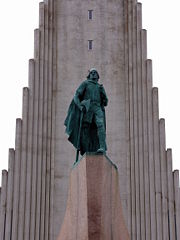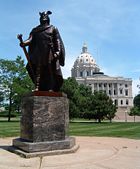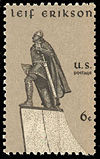Leif Ericson

Leif Ericson (Old Norse: Leifr Eiríksson)[1] (c. 970 – c. 1020) was a Norse[2] explorer who was probably the first European to land in North America (excluding Greenland).[3] According to the Sagas of Icelanders, he established a Norse settlement at Vinland, which has been tentatively identified with the L'Anse aux Meadows Norse site on the northern tip of the island of Newfoundland in Newfoundland and Labrador, Canada.
Contents |
Biography
Early life in Greenland
It is believed that Leif was born about AD 970 in Iceland,[4] the son of Erik the Red (Old Norse: Eiríkr inn rauði), a Norse explorer and outlaw and himself the son of an outlaw, Þorvaldr Ásvaldsson. Leif's mother was Thjodhild (Þjóðhildr).[5] Erik the Red had founded two Norse colonies in Greenland, the Western Settlement and the Eastern Settlement, as he named them.
Leif Erikson had two brothers, Thorvald and Thorsteinn, and one sister, Freydís. Leif married a woman named Thorgunna, and they had one son, Thorkell Leifsson.
Exploring west of Greenland
During a stay in Norway, Leif Ericson converted to Christianity,[6] like many Norse of that time, at the behest of the King of Norway, Olaf I. When he returned to Greenland, he bought Bjarni Herjólfsson's boat and set out to explore the land that Bjarni had seen (located west of Greenland), which likely was Newfoundland, Canada.
The Saga of the Greenlanders tells that Leif set out in the year 1003 or 1002 to follow Bjarni's route with 35 crew members, but going north.[7]
The first land he went to was covered with flat rocks (Old Norse hella). He therefore called it Helluland ("Land of the Flat Stones"). This was possibly Baffin Island. Next he came to a land that was flat and wooded, with white sandy beaches. He called this Markland ("Wood-land"), which is possibly Labrador.
Settlement in Vinland

Leif and his crew left Markland and again found land, which they named Vinland. They landed and built a small settlement. They found the area pleasant as there were wild grapes and plenty of salmon in the river. The climate was mild, with little frost in the winter and green grass year-round. They remained in the region over the winter.
On the return voyage, Leif rescued an Icelandic castaway named Þórir and his crew — an incident that earned Leif the nickname Leif the Lucky (Old Norse: Leifr hinn heppni).
Research done in the 1950s and 1960s by explorer Helge Ingstad and his wife, archaeologist Anne Stine Ingstad, identified a Norse settlement located at the northern tip of Newfoundland, known as L'Anse aux Meadows, which many have connected to Leif's settlement.
United States commemoration

In 1964, the United States Congress authorized and requested the president to proclaim October 9 of each year as "Leif Ericson Day". That date was chosen for its connection to the first organized immigration from Norway to the United States, not for any event in the life of the explorer. The day is also an official observance of several U.S. states.

See also

- John Cabot
- Matthew (ship)
Notes
- ↑ In modern Icelandic the first name is Leifur and in modern Norwegian Leif or Leiv. The patronym is Anglicized in various ways, such as Ericson, Eriksson, Ericsson, Erickson, Erikson and Eiriksson.
- ↑ Vísindavefurinn: Shouldn't Leifr Eiríksson ('Leif the Lucky') really be viewed as a Greenlander with family roots in Iceland and Norway?
- ↑ "Leif Erikson (11th century)". BBC. Retrieved on April 2008.
- ↑ In both Eiríks saga rauða and Landnáma, Leif's father is said to have met and married Leif's mother Þjóðhildur in Iceland, so Leif was in all likelihood born there. Leif also had many names (Leif, Leiv, etc.). However, no official site is known. See [1]
- ↑ Sanderson, Jeanette. (2002) Explorers, Teaching Resources/Scholastic. p. 14. ISBN 0-439-25181-8.
- ↑ [2] Leif Eriksson Encarta Encyclopedia].
- ↑ Another saga, The Saga of Eric the Red, relates that Leif discovered the American mainland while returning from Norway to Greenland in 1000 (or possibly 1001), but does not mention any attempts to settle there. However, the Saga of the Greenlanders is usually considered the more reliable of the two.
External links
- Account of the discovery of North America from the “Saga of Eric the Red”.
- A reconstructed portrait of Leif Ericsson – Based on historical sources, in a contemporary style; from Reportret: gallery of reconstructed portraits
- Biography at the Dictionary of Canadian Biography Online
- Leif Ericson Homepage – From the Great Norwegians webpages, hosted by Metropolitan News Company's website MNC Online.
- [3] A writing about the Vikings in "vinland".